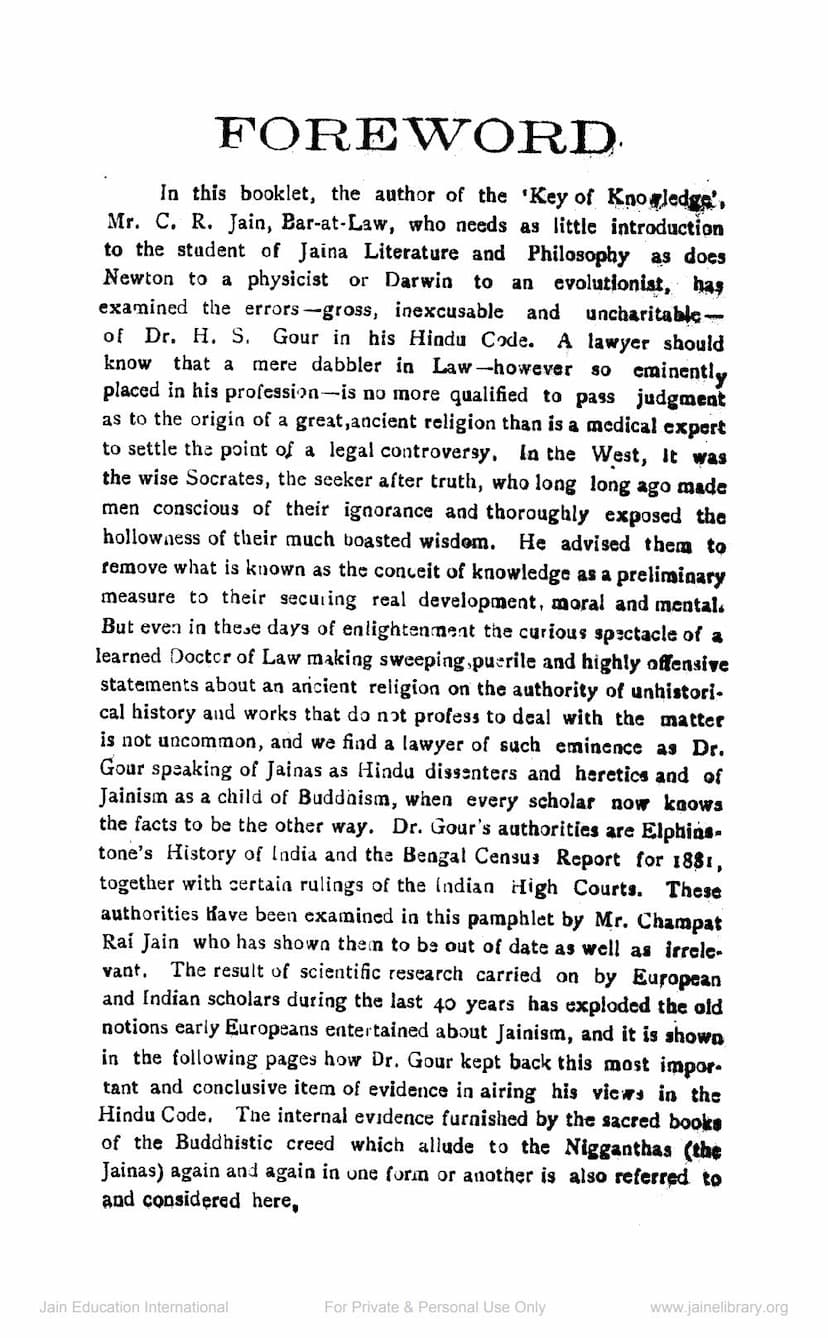Jainism And Dr Gours Hindu Code
Added to library: September 2, 2025

Summary
This document is a critique by Champat Rai Jain of the views presented by Dr. H.S. Gour in his "Hindu Code" regarding Jainism. The author, Champat Rai Jain, a prominent scholar of Jainism, argues that Dr. Gour's assertions about Jainism are inaccurate, based on outdated information, and show a lack of proper scholarship.
Here's a breakdown of the key points:
-
Critique of Dr. Gour's Claims: Champat Rai Jain directly refutes Dr. Gour's claims that:
- Jainism is a "child of Buddhism."
- Jainism is a "compromise between Buddhism and Hinduism."
- Jainas are "Hindu dissenters and heretics."
- Jainism is a later development that eventually merged back into Hinduism.
-
Outdated Authorities: The author highlights that Dr. Gour relies on authorities like Elphinstone's "History of India" and the Bengal Census Report of 1881. Champat Rai Jain argues that these sources are outdated and have been superseded by extensive scientific research conducted by European and Indian scholars over the past 40 years.
-
Evidence for Jainism's Antiquity and Independence: Champat Rai Jain presents a strong case for Jainism being an ancient and independent religion, predating Buddhism. He cites the following evidence:
- Scholarly Consensus: Leading Orientalists and researchers (European and Indian) now agree that Jainism is not an offshoot of Buddhism.
- Prof. T.W. Rhys Davids: States that Jains have remained an organized community from before the rise of Buddhism. He also notes that the Jaina Canon was reduced to writing in the 4th century B.C.
- Dr. T.K. Laddu: A Hindu scholar, asserts that Jainism is older than Buddhism and was likely founded by Parsva Nath or someone earlier.
- Dr. S.C. Vidyabhusana: Notes that Gautama, a direct disciple of Mahavira, was a contemporary of Buddha.
- Dr. J.G. Buhler: States that Buddhist scriptures confirm Jaina accounts of their prophet and that historical inscriptions prove the independent existence of the Jaina sect even during the early centuries after Buddha's death.
- Major-General J.G.R. Forlong: Suggests that Jainism, an ancient and organized religion, predated and influenced the early ascetical features of Brahmanism and Buddhism.
- The Encyclopaedia of Religion and Ethics: Confirms that the theory of Jainism being an offshoot of Buddhism is wrong and that Jainism is at least as old as Buddhism. It points out that Buddhist canonical books mention Jainas (Niganthas) as a rival sect and refer to Mahavira, agreeing with Jaina tradition regarding his place of death.
- Karma Theory and Terminology: The "Encyclopaedia of Religion and Ethics" also argues that the Jaina karma theory is original and integral to their system, as evidenced by terms like "asrava," which Buddhists borrowed and used in a modified sense, indicating the original meaning resided with the Jainas. This further supports Jainism's antiquity.
- Buddha's Own References: The author cites passages from Buddhist scriptures where Buddha refers to Mahavira and the Jaina creed, including their belief in the annihilating power of tapas and the claim of Mahavira's omniscience. Buddha's own struggles and quest for enlightenment are linked to observing Mahavira.
-
Refutation of "Hindu Dissenters" Claim: Champat Rai Jain dismisses the notion of Jainas being "Hindu dissenters" as a baseless assumption rooted in the misunderstandings of early European scholars. He argues that while there might be superficial resemblances due to centuries of coexistence and cultural exchange, it doesn't prove one religion is an offshoot of the other. He specifically addresses arguments like shared doctrines, the caste system, and the worship of Hindu deities by some Jainas, demonstrating their inadequacy as proof of dissent.
-
Jaina Scriptures and Law: The author mentions several ancient Jaina law books like "Bhadrabahu Samhita," "Vardhman Niti," and "Arhana Niti," asserting their independence from Brahmanical influence.
-
Historical Context of Rulings: Champat Rai Jain analyzes a specific High Court ruling from 1873 (10 Bomb. H.C. Reports pp. 241-267) which relied on outdated authorities and the opinions of scholars like Rev. Dr. Wilson. He attributes the inaccuracies in such rulings to the prevailing lack of knowledge about Jainism at the time and the difficulty in accessing Jaina scriptures, especially during periods of persecution by invaders.
-
Call for Correction: The foreword and the concluding remarks express the hope that Dr. Gour will acknowledge his errors and correct the "Hindu Code" with the updated and accurate information presented in Champat Rai Jain's critique.
In essence, the document is a scholarly defense of Jainism's historical and theological independence, directly challenging and disproving the inaccuracies presented in Dr. Gour's "Hindu Code" by drawing on modern research and ancient scriptures.